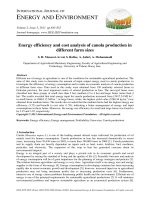Calculation of neutronic characteristics in different reflector materials with a 15-MWt reactor core using VVR-KN fuel type
Bạn đang xem bản rút gọn của tài liệu. Xem và tải ngay bản đầy đủ của tài liệu tại đây (241.15 KB, 7 trang )
Nuclear Science and Technology, Vol.7, No. 4 (2017), pp. 09-15
Calculation of neutronic characteristics in different reflector
materials with a 15-MWt reactor core using VVR-KN fuel type
Bui Phuong Nam, Huynh Ton Nghiem, Nguyen Nhi Dien and Le Vinh Vinh
Nuclear Research Institute, 01 Nguyen Tu Luc Street, Dalat, Viet Nam
E-mail:
(Received 04 November 2017, accepted 28 December 2017)
Abstract: VVR-KN is one of the low enriched fuel types intended for a research reactor of a new
Centre for Nuclear Energy Science and Technology (CNEST) of Viet Nam. As a part of design
orientation for the new research reactor, the calculations of neutronic characteristics in a reactor core
reflector using different materials were carried out. The investigated core configuration is a 15-MWt
power loaded with VVR-KN fuel assemblies and surrounded by a reflector using beryllium, heavy
water or graphite respectively. MCNP5 code together with up-to-date nuclear data libraries were used
for these calculations. This paper presents the calculation results of neutron energy spectrum, neutron
spatial distribution in the reflector using the above-mentioned materials. Besides, neutronic
characteristics calculated for silicon doping irradiation holes in the reflector are also presented and the
utilization capabilities of different reflector materials are discussed.
Keywords: VVR-KN fuel, MCNP5, reflector materials, silicon doping irradiation hole.
I. INTRODUCTION
Vietnam is planning to build a new
research reactor (RR) with an estimated power
of about 10-15 MWt for the CNEST in cooperation with Russian Federation (RF). For
this purpose, the national research project on
design calculation of neutronic characteristics,
thermo-hydraulics and safety analysis of the
new multi-purpose RR has been carried out. As
a part of the research project, this work aims at
calculations of neutronic characteristics in a
reflector using different materials surrounding
the reactor core loaded with Russian VVR-KN
fuel type [1].
Materials used for reactor core reflector
play an important role in the effective
utilization of RRs, as reflectors usually are
used for flattening the thermal neutron flux and
power distribution, as well as reducing the
critical size and fuel mass of the reactor core.
In proposed design, a set of three material
types including beryllium, heavy water, or
graphite were selected to study neutronic
characteristics in the reflector.
VVR-KN fuel is a low-enriched fuel
manufactured by RF that has been tested in the
6-MWt WWR-K research reactor of
Kazakhstan and officially used for this reactor
since 2016 in the framework of the conversion
project of its core from highly to low enriched
fuel [2, 3].
This report presents the calculated
results of neutronic characteristics of the
reflector using beryllium, heavy water or
graphite respectively. In addition, a neutronspecific investigation of an irradiation hole for
silicon single-crystal doping, which is one of
currently important applications of RRs
worldwide, was also conducted and calculated
results were given. Those results allow to
examine the potential of applying neutron
fields in different reflective materials. The
Monte Carlo code has been used for those
calculations [4].
©2017 Vietnam Atomic Energy Society and Vietnam Atomic Energy Institute
CALCULATION OF NEUTRONIC CHARACTERISTICS IN DIFFERENT REFLECTOR MATERIALS …
II. CALCULATION METHOD, RESULTS
AND DISCUSSION
Program and model calculation
The MCNP5 developed by Los Alamos
Laboratories is a multi-functional program for
calculating neutron, photon, electron or coupled
neutron/ photon/ electron transport by Monte
Carlo method [4]. This program can be used to
simulate for radiation shielding, critical safety,
reactor design, etc. The program handles
arbitrary three-dimensional configurations
containing material in the cell surrounded by the
first, second, and fourth elliptical planes. MCNP
uses continuous atomic and nuclear energy
database libraries. Almost data sources get from
data libraries which have been evaluated and
processed in MCNP format by programs such as
NJOY [5, 6].
A. Method and calculation program
VVR-KN fuel
Fig. 1 shows the Russian 19.75%
enriched VVR-KN fuel assembly (FA) which
consists of two types: the standard one with 1
cylindrical and 7 hexagonal coaxial tubes, and
the other with 5 hexagonal coaxial tubes for
control rod placement. Table I shows the
technical parameters of VVR-KN FAs. The
width from the edge to the edge of the outer
hexagonal tube is 66.3 mm. The thickness of
fuel tube is 1.6 mm, consisting of 0.7-mm
UO2-Al fuel meat and 0.45-mm aluminum
cladding on each side. The length of the fuel
meat is 600 mm. The total amount of 235U is
248.2 g in the standard FA and 197.6 g in the
FA for control rod placement.
In this study, the 15-MWt reactor core
surrounded by the reflector was modeled
according to the geometry of each component
including all VVR-KN FAs (50 standard and
10 for control rod placement), a reflective layer
by beryllium rods at the core periphery with an
average thickness of 6.9 cm, an outer
hexagonal reflector with beryllium, heavy
water or graphite materials, irradiation holes,
etc. Nuclear data is used based on the lasted
ENDF-B/7.1 nuclear data library. Fig. 2 shows
the cross-section of the reactor core using
VVR-KN fuel type.
Fig. 1. Two types of VVR-KN FA.
Table I. Technical parameters of VVR-KN FAs.
Parameter
Fuel material
VVR-KN with 5/8
fuel elements
UO2-Al
Enrichment in U-235, %
19.75
U-235 content in FA, g
197.6/ 248.2
Thickness of fuel tube, mm
1.6
Thickness of fuel meat, mm
0.7
Thickness of cladding, mm
0.45
Width of outer tube, mm
66.3
Length of fuel meat, mm
600
10
BUI PHUONG NAM et al.
respectively. Fig. 3 also shows that thermal
neutron flux in beryllium declines rapidly
when away the core with the high non-linear
while with heavy water and graphite reflectors,
thermal neutron fluxes decrease more slowly
and relatively linearly. The main reason is that
the thermal neutron absorption cross section in
the beryllium reflector is highest, followed by
graphite and heavy water ones respectively.
Meanwhile the thermal neutron diffusion
coefficient in beryllium reflector is lowest,
followed by graphite and heavy water ones
respectively. This also explains the relative
distribution of thermal neutron flux in the
reflector in axial direction as shown in Fig. 4.
Water hole at the core center
FA with control rod
Standard FA
Beryllium rod
Aluminum tank
Hexagonal reflector
Silicon doping irradiation hole
Fig 2. The core configuration using VVR-KN fuel.
Thermal neutron flux (n/cm2.s)
The hexagonal core with 60-cm height
according to the length of fuel meat section, is
coverred by 1.5-cm thick aluminum tank. A
water hole at the core center is as a neutron
trap with the highest thermal neutron flux.
Surrounding the FAs are beryllium rods which
act as a reflective layer at the core periphery.
Outside the aluminum tank, a hexagonal
reflector using different reflective materials
such as beryllium, heavy water or graphite in
which 6- or 8-inch irradiation hole for silicon
single-crystal doping is located.
1.E+14
9.E+13
8.E+13
7.E+13
6.E+13
5.E+13
4.E+13
3.E+13
2.E+13
1.E+13
0.E+00
Heavy water
Graphite
Beryllium
35
40
45
50
55
60
65
70
Distance from the core center (cm)
The present work aims at calculating
neutron spectrum and spatial neutron
distribution in this hexagonal reflector with
different reflective materials. In addition, a
number of computational results for silicon
doping irradiation hole as an example for
potential applications of different reflective
materials have also been presented.
Fig. 3. Thermal neutron distribution in
different materials of the reflector.
Thermal neutron flux (n/cm2.s)
1.1
B. Results
The results of calculating the thermal
neutron distribution in the reflector with
different materials are shown in Fig. 3.
Positions with maximum thermal neutron flux
of beryllium, heavy water or graphite reflector
are at 37.7 cm, 39.8 cm and 36 cm from the
core center and the neutron flux values are of
8.6.1013, 9.21013 and 6.9.1013 n.cm-2s-1,
1.0
0.9
0.8
Graphite
0.7
Heavy water
0.6
0.5
Beryllium
0.4
0
5 10 15 20 25 30 35 40 45 50 55 60
Distance from bottom to top of FA (cm)
Fig. 4. Relative distribution of thermal neutron flux
in different materials of the reflector in axial.
11
CALCULATION OF NEUTRONIC CHARACTERISTICS IN DIFFERENT REFLECTOR MATERIALS …
Fig. 5 shows the ratio of thermal to fast
neutrons in the above reflective materials,
where in the heavy water environment the ratio
is highest followed by beryllium and graphite.
This is explained by the ability to slow down
neutrons in these environments.
Thermal neutron flux (n/cm2.s)
1.E+14
Thermal /fast neutron
400
350
7.E+13
6.E+13
Graphite
5.E+13
Graphite+6 cm
4.E+13
3.E+13
2.E+13
0.E+00
250
35
Beryllium
200
100
Graphite
As usual, there are four typical
applications of using neutron fields in the
reflector of RRs: neutron activation
analysis, radioactive isotope production,
neutron beam researches and irradiation
services. The first two applications may not
require high quality of neutron flux, such as
flux distribution and stability etc., but just
the suitable flux level. Meanwhile the rest
requires high neutron flux as well as high
quality of neutron flux [7].
0
35
45
55
65
75
Distance from the core center (cm)
Fig. 5. The ratio of thermal to fast neutron using
beryllium, heavy water or graphite reflector.
With applications requiring high thermal
neutron flux, in case of using graphite
reflector, the ratio of thermal to fast neutrons
should be improved by adding a beryllium
layer to further slow down neutrons until this
ratio is reached as required. Fig. 6 shows the
ratio of thermal to fast neutrons and Fig. 7
shows the thermal neutron flux distribution in
case of adding 6-cm thick beryllium layer to
graphite reflector. The calculated results show
that the ratio of thermal to fast neutrons and the
neutron flux distribution are improved. It
means, the thermal neutron flux increases and
the neutron flux distribution relatively flattens.
400
350
300
250
200
150
100
50
0
Beryllium
With the neutron beam application,
neutron guides are used to extract and lead
neutron beams outside for material structure
study and other basic and applied research
purposes. Most neutron beam researches
require beam quality with the fast neutron and
gamma field are as low as possible. Based on
the above results obtained, it was found out
that beryllium and heavy water reflectors are
suitable for neutron beam application which
requires the high thermal neutron flux (see Fig.
3 and Fig. 5). However, heavy water reflector
is better than beryllium reflector for neutron
beam application due to the thermal neutron
flux peak, the ratio of thermal to fast neutrons
are higher, and in particular the peak position
is far away from the core region that allows to
layout experimental devices easier. According
to [7], for achieving the best beam quality,
Graphite+6
Graphite
35
45
55
45
55
65
Distance from the core center (cm)
Fig. 7. Thermal neutron distribution in case of
adding 6-cm thick beryllium to graphite reflector.
150
50
Thermal/ fast neutron
Beryllium
8.E+13
1.E+13
Heavy water
300
9.E+13
65
Distance from the core center (cm)
Fig. 6. The ratio of thermal to fast neutrons in case
of adding 6-cm thick beryllium layer.
12
BUI PHUONG NAM et al.
most neutron beam tubes in the latest
constructed RRs are tangentaligned with the
core to minimize the fast neutron and gamma
effects.
Thermal neutron flux
(neutron/cm2.s)
3.5E+13
3.0E+13
Heavy water
2.5E+13
Graphite
2.0E+13
Among various areas of RR utilization,
neutron transmutation dopping of singlecrystals silicon (silicon NTD) is a typical
application, especially for producing semiconductor with high quality. This application
requires high enough thermal neutron flux to
shorten the irradiation time. Since fast
neutrons create extended charged lattice
defects in a crystal, the fast neutron flux in
the irradiation position must be as low as
possible [8].
1.5E+13
Beryllium
1.0E+13
5.0E+12
0.0E+00
50
55
60
65
70
Distance from the center(cm)
Fig. 8. Thermal neutron flux in 6-inch silicon
irradiation hole at different positions in different
reflector materials.
400
Thermal/fast neutron
350
Gamma rays are the major source of
heat generation in the ingot, so the gamma
field should also be as low as possible, and
the ingot must be sufficiently cooled during
the irradiation. Specific requirements of high
uniformity of neutron field both in radial and
in axial directions should be concerned as
well [8].
Heavy water
300
250
Beryllium
200
150
Graphite
100
50
0
50
55
60
65
Distance from the core center(cm)
70
Fig. 9. The ratio of thermal to fast neutron flux at
the 6-inch hole for silicon doping.
Figs. 3 and 4 show that heavy water
reflector is better than beryllium one for silicon
doping service. In adition, this application also
requires a large enough space and the decretion
of flux has shown limited use of beryllium
reflectors.
For
single-crystal
silicon-doped
irradiation application, on the market today the
most common sizes are 6 inches and 8 inches
(150 mm and 200 mm) that are quite large
compared to the reactor reflector size.
According to [8], an integral flux value of
6x1017 n.cm-2 is required to produce single
crystals with a resistivity of 50 Ω.cm, the
common resistivity at market demand. With a
flux of 7x1012 to 3.2x1013 n.cm-2s-1, it takes
about from 5 to 24 hours to achieve the above
resistivity. According to the purely economic
criterion, heavy water is the best reflector, next
is graphite and finally beryllium.
C. Discussion
The results of calculating the neutron
specificity for 6- and 8-inch silicon doping
irradiation holes are given in Tables I and
II, and described in Figs. 8 and 9. The
thermal neutron flux in irradiation holes
with reflective materials surveyed from
7x10 12 to 3.2x10 13 n.cm-2s -1 and the ratio of
thermal to fast neutrons from a few tens to a
few hundreds were acceptable for this
application [9].
Considering the ratio of thermal to fast
neutrons, the acceptable value is more than
13
CALCULATION OF NEUTRONIC CHARACTERISTICS IN DIFFERENT REFLECTOR MATERIALS …
7, but due to the fast neutron affecting the
quality of semiconductor crystals, this
number should be as high as possible [8].
The calculated results show that heavy water
is the best reflective material for this ratio,
followed by beryllium and finally graphite
(see Fig. 9). With this criterion, when using
graphite for the reflector, it can be improved
by adding a beryllium reflector layer as
mentioned above.
axial rotation of the silicon ingot. Although
silicon crystals are transparent with thermal
neutrons, but the decrease of thermal neutrons
in the 6-inch ingot is also caused nonuniformity approximately 2%. In addition, the
slope and non-linearity of the neutron field also
contribute significantly to this inequality.
Although the requirement of discrepancy in the
radial and axial directions is no more than 5%
for 6-inch crystals, but practically some silicon
irradiation facilities achieve an unequal
approximation in the axial direction of 2.5%
[9]. Based on this criterion, the three best
reflective materials were examined and the
results obtained show that the best is graphite
followed by heavy water and the worst is
beryllium reflector (see Figs. 3 and 4).
The homogeneity criterion of resistivity
is most important in the doping of silicon
single-crystal. The axial uniformity is usually
achieved by moving silicon ingots through the
neutron field, or by using different materials to
smooth the neutron flux distribution along the
cavity [8]. The radial uniformity obtains by
Table II. Neutron flux in 6-inch silicon doping irradiation holes using heavy water, beryllium
and graphite reflectors.
Neutron flux (neutron.cm-2.s-1)
Position
(cm)
Heavy water reflector
Thermal Epithermal
13
4,0.10
12
Beryllium reflector
Fast
4,5.10
Thermal
11
2,3.10
Epithermal
13
3,2.10
12
Graphite reflector
Fast
5,2.10
Thermal Epithermal
11
3,0.10
13
7,0.10
Fast
12
1,0.1012
53
3,2.10
57
2,7.1013
2,2.1012
2,4.1011
1,7.1013
1,6.1012
2,5.1011
2,5.1013
4,8.1012
6,6.1011
61
2,2.1013
1,2.1012
1,2.1011
1,3.1013
7,3.1011
1,2.1011
2,1.1013
3,4.1012
4,2.1011
65
1,9.1013
6,7.1011
6,8.1010
9,1.1012
3,6.1011
6,0.1010
1,7.1013
2,3.1012
2,7.1011
69
1,5.1013
3,5.1011
3,7.1010
6,9.1012
1,8.1011
2,9.1010
1,4.1013
1,5.1012
1,8.1011
Table III. Neutron flux in 8-inch silicon doping irradiation holes using heavy water, beryllium
and graphite reflectors.
Neutron flux (neutron.cm-2.s-1)
Position
(cm)
Heavy water reflector
Thermal
13
Epithermal
3,1.10
12
Beryllium reflector
Fast
3,6.10
Thermal Epithermal
11
1,7.10
13
Fast
4,0.10
Thermal Epithermal
11
2,3.10
13
5,6.10
Fast
12
8,3.1011
56
2,5.10
58
2,3.1013
2,3.1012
2,6.1011
1,5.1013
1,7.1012
2,8.1011
2,1.1013
4,7.1012
6,6.1011
61
2,0.1013
1,5.1012
1,6.1011
1,2.1013
1,0.1012
1,6.1011
1,8.1013
3,5.1012
4,7.1011
64
1,7.1013
9,7.1011
9,6.1010
9,5.1012
6,0.1011
9,2.1010
1,6.1013
2,7.1012
3,3.1011
67
1,5.1013
5,9.1011
5,7.1010
7,6.1012
3,3.1011
5,4.1010
1,4.1013
2,0.1012
2,4.1011
14
2,5.10
12
Graphite reflector
BUI PHUONG NAM et al.
III. CONCLUSIONS
REFERENCES
As a part of the national research project
on calculation of neutronic characteristics,
thermo-hydraulics and safety analysis of
research reactor proposed by the Russian
Federation for the CNEST of Vietnam, the
authors have performed neutron-specific
calculations in beryllium, heavy water and
graphite reflective materials surrounding a 15MWt reactor core loaded with VVR-KN FAs
and at silicon doping irradiation holes of
different reflective materials. The purpose of
this work is to review the advantages and
disadvantages of reflective materials for typical
applications on the research reactor.
[1] National research project “Study on calculation
of neutronic characteristics, thermo-hydraulics
and safety analysis of a new research reactor
proposed by the Russian Federation for the
Centre for Nuclear Energy Science and
Technology of Viet Nam”, ĐTĐL-CN.50/15,
Ha Noi, 2016.
[2] F. Arinkin, et al., “Results of the Trial of Lead
Test Assemblies in the WWR-K Reactor”,
RRFM Conference, Slovenia, 2014.
[3]
A. A. Shaimerdenov, et al., “Physical and
Power Start-up of WWR-K Research Reactor
with LEU Fuel”, RERTR Intenational
Meeting, Belgium, 2016.
[4] Forrest B. Brown, et al., “MCNP – A General
Monte-Carlo N-Particle Transport Code
Version 5”, LA-UR-03-1987, Los Alamos
National Laboratory, 2008.
The calculated results show that, based
on the criteria used on horizontal experimental
channels to conduct neutron beams for
experiments, heavy water and beryllium
reflectors have more advantages than graphite
due to the thermal neutron peak is higher, in
which, heavy water reflector is better than
beryllium one due to the thermal neutron flux
peak and the ratio of thermal to fast neutrons
are higher.
[5] Nguyen Nhi Dien et al., “Some main results of
commissioning of the Dalat research reactor
with low enriched fuel”, Nuclear Science and
Technology, Vol. 4, No. 1 (2014), pp. 35-45.
[6] A. C. Kahler, et al., “The NJOY Nuclear Data
Processing System”, LA-UR-12-27079, Los
Alamos National Laboratory, 2012.
For neutronic characteristics calculations
of 6- and 8-inch silicon doping irradiation
holes to make semiconductor, the calculated
results show that heavy water and beryllium
reflectors bring a higher ratio of thermal to fast
neutrons than graphite reflector. However,
silicon doping irradiation holes in heavy water
and graphite reflectors have more advantages
in thermal neutron flux values and particularly
about linearity level and slope in thermal
neutron distribution. Thus, besides of the
outstanding advantages of heavy water
reflector, the reflector using both beryllium and
graphite to reduce the disadvantages of these
two materials should be considered.
[7]
“Utilization Related Design Features of
Research
Reactors:
A
Compendium”,
Technical Reports Series No. 455, IAEA,
Vienna, 2007.
[8] “Neutron Transmutation Doping of Silicon at
Research Reactors”, IAEA-TECDOC-1681,
Vienna, 2012.
[9] Hak-Sung Kim et al., “Design of a Neutron
Screen for 6-inch Neutron Transmutation
Doping in HANARO”, Nuclear Engineering
and Technology, Vol. 38, No. 7, 2006.
15









